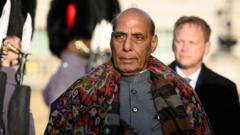**This article delves into the evolving landscape of the hair industry in India, showcasing the journey of drag artist Zeeshan Ali and hair collectors like Kolachi Venkatesh, while highlighting the potential of Indian hair in the global market.**
**The Transformative Power of Indian Human Hair in the Wig Industry**

**The Transformative Power of Indian Human Hair in the Wig Industry**
**Exploring the Rise of Wigs: From Drag Performance to a Global Commodity**
In recent years, the perception and use of wigs in India have undergone a significant transformation, emerging as symbols of identity and empowerment rather than mere accessories. Zeeshan Ali, a celebrated drag artist based in Mumbai with a decade of experience, emphasizes the essential role his collection of 45 wigs plays in his performances. “Wigs facilitate my transition from an everyday persona to glamorous or whimsical characters, empowering me to take charge of the stage,” he shares.
However, the journey to find the perfect wigs was arduous initially. Ali recalls the challenges he faced: “In the early days, accessing quality wigs in India was nearly impossible. I often had to create makeshift wigs from materials such as wool and fabric.” Fortunately, these challenges have lessened as wigs gain popularity among diverse audiences, including straight women who now use them to shift their styles.
India stands as the leading exporter of human hair, catering to 85% of the global demand. Kolachi Venkatesh, who has spent 20 years collecting hair, began his career as a picker, salvaging hair from homes and barbershops. “My parents did this, and I continued the tradition,” he explains. Collected hair—classified as non-Remy—though less valuable than Remy hair, is viewed as hidden potential. “It may be discarded, but it’s gold,” asserts Venkatesh.
The economic reality for pickers remains challenging, with earnings usually falling below minimum wage. Venkatesh notes, “A diligent collector may earn just between 59 cents to $6 a day, despite contributing to a billion-dollar market.” Most Indian hair finds its way to China, where it fuels a thriving wig-making industry valued between $5 to $6 billion.
Benjamin Cherian, representing the hair industry body Plexconcil, highlights the urgent need for India to enhance its production capabilities to compete more effectively with China, where hundreds of wig factories operate. “We need advancements in hair treatment processes and creative manufacturing techniques to elevate India’s position in the industry,” he emphasizes.
Organizations like Diva Divine Hair, co-founded by Nidhi Tiwari in 2009, are making strides in this regard. The company specializes in quality wigs and extensions aimed at women facing hair loss, a topic that has transitioned into mainstream discussion over the years. "Social acceptance has led to a growing demand,” Tiwari states, noting advancements in technology, such as 3D-printed wigs, that enhance both aesthetic appeal and comfort.
At the high end of the market is Temple or Remy hair, sourced from Hindu temples, where devotees have their hair shaved as an act of devotion. Raj Hair International, a major player in this sector, takes pride in its meticulous sorting processes that maximize the use of hair. “Our aim is to continuously improve our technology for efficiency,” states CEO George Cherion.
As the demand for high-quality Indian hair surges globally, Zeeshan Ali expresses hope for greater local production. He envisions “affordable wigs that inspire awe,” pointing to a promising future where Indian wigs dominate the market.
However, the journey to find the perfect wigs was arduous initially. Ali recalls the challenges he faced: “In the early days, accessing quality wigs in India was nearly impossible. I often had to create makeshift wigs from materials such as wool and fabric.” Fortunately, these challenges have lessened as wigs gain popularity among diverse audiences, including straight women who now use them to shift their styles.
India stands as the leading exporter of human hair, catering to 85% of the global demand. Kolachi Venkatesh, who has spent 20 years collecting hair, began his career as a picker, salvaging hair from homes and barbershops. “My parents did this, and I continued the tradition,” he explains. Collected hair—classified as non-Remy—though less valuable than Remy hair, is viewed as hidden potential. “It may be discarded, but it’s gold,” asserts Venkatesh.
The economic reality for pickers remains challenging, with earnings usually falling below minimum wage. Venkatesh notes, “A diligent collector may earn just between 59 cents to $6 a day, despite contributing to a billion-dollar market.” Most Indian hair finds its way to China, where it fuels a thriving wig-making industry valued between $5 to $6 billion.
Benjamin Cherian, representing the hair industry body Plexconcil, highlights the urgent need for India to enhance its production capabilities to compete more effectively with China, where hundreds of wig factories operate. “We need advancements in hair treatment processes and creative manufacturing techniques to elevate India’s position in the industry,” he emphasizes.
Organizations like Diva Divine Hair, co-founded by Nidhi Tiwari in 2009, are making strides in this regard. The company specializes in quality wigs and extensions aimed at women facing hair loss, a topic that has transitioned into mainstream discussion over the years. "Social acceptance has led to a growing demand,” Tiwari states, noting advancements in technology, such as 3D-printed wigs, that enhance both aesthetic appeal and comfort.
At the high end of the market is Temple or Remy hair, sourced from Hindu temples, where devotees have their hair shaved as an act of devotion. Raj Hair International, a major player in this sector, takes pride in its meticulous sorting processes that maximize the use of hair. “Our aim is to continuously improve our technology for efficiency,” states CEO George Cherion.
As the demand for high-quality Indian hair surges globally, Zeeshan Ali expresses hope for greater local production. He envisions “affordable wigs that inspire awe,” pointing to a promising future where Indian wigs dominate the market.





















